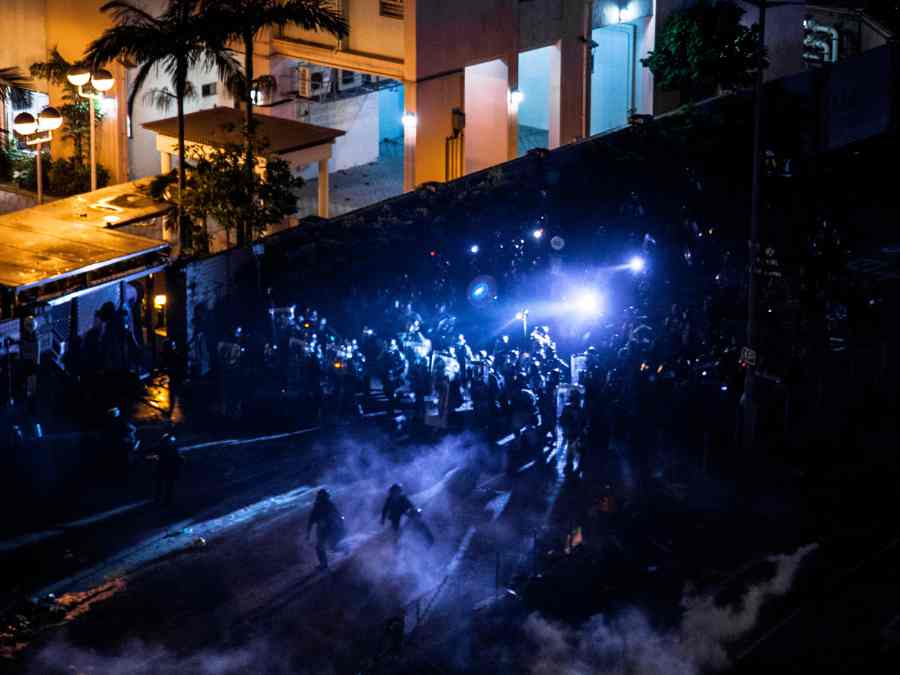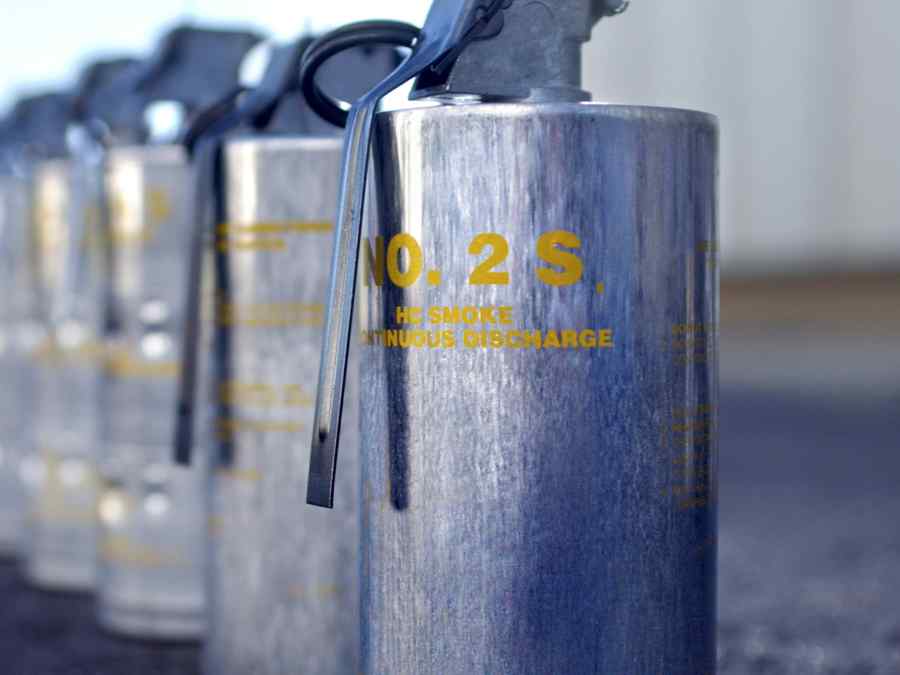What is Tear Gas?
Tear gas is a term used to describe various chemical compounds that cause irritation to the eyes, skin, and respiratory system. These compounds are often used by law enforcement and military personnel for crowd control and riot suppression. They’re designed to be non-lethal, but their use can still result in severe discomfort and, in some cases, serious injury.
How Does Tear Gas Work?
Tear gas works by irritating the mucous membranes in the eyes, nose, mouth, and lungs. This irritation causes the production of tears, coughing, and difficulty breathing. The chemicals in tear gas also stimulate pain receptors in the skin, leading to a burning sensation. These effects are typically temporary, but can cause severe discomfort and disorientation, making it difficult for individuals to continue their actions or resist authorities.
You may have heard of tear gas being used in protests or riots on the news, but what exactly is it and how does it work? Tear gas is a chemical substance that’s used by law enforcement as a means of crowd control.
It’s designed to be non-lethal and cause temporary discomfort to those exposed to it. In this article, we’ll dive into the details of tear gas, including its chemical composition, history of use, effects on the body, production and regulation methods, and alternatives.
Tear Gas in Law Enforcement
Tear gas was first developed in France during World War I as a means of chemical warfare. It wasn’t until later that it was adapted for use by law enforcement agencies as a method of crowd control.
The idea behind using tear gas is to disperse crowds without resorting to more violent tactics like physical force or firearms. It’s considered less lethal than those methods but still effective at achieving the same goal.
Tear gas can be delivered through various means such as grenades or spray cans. When deployed, the gas emits a strong odor that can be detected from several feet away.

The vapor released causes irritation to the nose and eyes which stimulates excessive tearing, coughing, and even shortness of breath – hence the name “tear” gas. While tear gas is meant to be non-lethal, it has been known to cause serious injury or even death in some cases – particularly if an individual has pre-existing respiratory issues or is otherwise sensitive to certain chemicals found in tear gas formulations.
Injuries caused by tear gas are generally rare when compared with other forms of force but they do occur occasionally. Despite its potential harm when mishandled, tear gas remains a popular choice for law enforcement agencies across the world.
Its non-lethal nature has made it a more attractive option than other crowd control methods and it’s currently used in many countries worldwide. In the next section, we’ll explore the chemical composition of tear gas – what makes it so effective at causing such strong reactions in those exposed to it.
Types of Tear Gas
There are several types of tear gas, each with its unique properties and effects. The most common types include:
CS Gas
CS gas, or 2-chlorobenzalmalononitrile, is the most commonly used tear gas worldwide. It is a powerful irritant that causes tearing, coughing, and a burning sensation on the skin.
CN Gas
CN gas, or chloroacetophenone, is an older tear gas compound that has been largely replaced by CS gas. It is less potent but can still cause significant discomfort and irritation.
CR Gas
CR gas, or dibenzoxazepine, is a stronger irritant than CS gas and is more likely to cause severe respiratory distress. It is less commonly used due to its increased potential for causing harm.
OC Spray
OC spray, or oleoresin capsicum, is derived from chili peppers and is the active ingredient in pepper spray. It causes an intense burning sensation and can result in temporary blindness.
Chemical Composition
Tear gas is a chemical compound that is commonly used for crowd control by law enforcement agencies around the world. The active ingredient in tear gas typically falls into one of two categories: irritants or lachrymators. Irritants, such as CS (chlorobenzylidene malononitrile), work by causing a burning sensation on the skin and in the eyes, while lachrymators, such as CN (chloroacetophenone), cause excessive tearing and mucous production.
Explanation of the Chemical Compounds
The chemical compounds found in tear gas can vary depending on the type of tear gas being used. However, most tear gases are made up of synthetic organic compounds that are designed to be highly irritating to human tissue. These compounds act on various nerve receptors in the body, causing an intense physical response that includes pain, inflammation, and involuntary muscle contractions.
Discussion on Different Types of Tear Gases and Their Compositions
There are several types of tear gases that are commonly used for crowd control purposes. Some of the most common types include CS (chlorobenzylidene malononitrile), CN (chloroacetophenone), CR (dibenz[b,f]-1,4-oxazepine), and OC (oleoresin capsicum). Each type of tear gas has a slightly different chemical composition and produces different effects on those exposed to it.
CS is one of the most widely used types of tear gas and is typically delivered in powder form or as an aerosol spray. It works by targeting nerve receptors in the body and causing an intense burning sensation on exposed skin and mucous membranes.
CN is another popular type of tear gas that is often used by law enforcement agencies around the world. It produces similar effects to CS, but is less potent and has a shorter duration of action.
CR is a newer type of tear gas that was developed in the 1960s. It is highly effective at producing irritation of the skin and eyes, but is relatively non-toxic compared to other types of tear gases.
OC is a chemical compound that is derived from hot peppers. It produces intense pain and inflammation when it comes into contact with human tissue, making it an effective non-lethal weapon for crowd control purposes.
Effects on the Body
Description of how tear gas affects the body upon exposure
Tear gas is a non-lethal weapon that law enforcement agencies use to disperse crowds or control public riots. The chemical compounds that make up tear gas cause an immediate reaction in the body, leading to intense physical and emotional effects.
Upon exposure, a person’s eyes will begin to burn and water profusely, while their nose will run uncontrollably. The skin also experiences an intense burning sensation that can last for hours after exposure.
Tear gas can also cause coughing and difficulty breathing, as it irritates the respiratory system. These effects usually subside after a few minutes of leaving the affected area.
Discussion on the short-term and long-term effects of tear gas exposure
The short-term effects of tear gas exposure include those mentioned above, such as burning eyes, runny nose, coughing, and difficulty breathing. However, prolonged or repeated exposure can lead to more serious health problems.
Studies have shown that long-term exposure to tear gas may increase the risk of respiratory infections, asthma attacks, chronic bronchitis, and even lung cancer. Tear gas has also been known to cause skin irritation and rashes in some individuals.
It is important to note that pregnant women should avoid contact with tear gas as it may cause harm to their unborn child. While most people recover from short-term exposure with no lasting effects on their health, long-term or repeated exposure should be avoided whenever possible.
Effects of Tear Gas Exposure
Exposure to tear gas can result in a range of symptoms, including:
- Watery, burning eyes
- Runny nose
- Coughing and difficulty breathing
- Burning, stinging skin
- Nausea and vomiting
- Disorientation
In some cases, exposure to high concentrations of tear gas or prolonged exposure can lead to more serious complications, such as chemical burns, respiratory distress, or even death.
History of Tear Gas Use
The Evolution of Tear Gas in Warfare and Law Enforcement
Tear gas has a long and complex history, dating back to the early 20th century when it was first used by the French military. It wasn’t until the 1920s that tear gas was utilized by law enforcement as a crowd control measure. In its early days, tear gas was seen as a humane alternative to lethal force, but over time, it became clear that it could be just as dangerous.
Notable Events Where Tear Gas Was Used
Throughout history, there have been numerous events where tear gas was deployed as a means of crowd control or in warfare. One of the most infamous uses of tear gas was during World War I, when both sides used chemical weapons including tear gas against one another. In more recent times, we have seen tear gas deployed at protests and demonstrations around the world, including during the Hong Kong protests in 2019 and Black Lives Matter protests in the United States.
Tear Gas as Controversial Crowd Control Measure
While tear gas has been used for many decades as a crowd control measure by law enforcement agencies around the world, its use has increasingly come under scrutiny due to concerns about its potential harm to civilians. Tear gas can cause respiratory issues and even lead to death if not used properly or in excessive quantities.
This has led many organizations to call for bans on its use except in extreme circumstances where there is no other option available. Overall, while tear gas may have once been viewed as a non-lethal alternative to forceful measures like rubber bullets or batons, its use remains controversial due to concerns about safety and potential harm when deployed indiscriminately.
Production and Regulation
Explanation on how tear gas is produced
Tear gas, also known as riot control agents, is produced through a chemical reaction between two or more compounds. The most commonly used compound for producing tear gas is 2-chlorobenzalmalononitrile (CS). To make CS, first, chloroacetone is reacted with malononitrile in the presence of a strong base.
The reaction produces an intermediate compound that reacts with chlorine gas to form CS. The resulting product is then purified and processed into various delivery systems such as grenades, spray cans or cartridges.
Regulations surrounding the manufacturing, distribution and use of tear gas.
Tear gas has been classified as a chemical weapon by many countries but still widely used by law enforcement agencies around the world for crowd control purposes. However, there are international conventions regulating its use in warfare and armed conflict. In addition to military regulations, each country has its own set of laws governing the production, distribution and use of tear gas for domestic purposes.
The production process must meet specific safety standards as it involves hazardous chemicals that require careful handling at each stage to prevent unintended exposure during manufacturing. Manufacturers must also ensure that their products meet certain quality standards before they can be sold to law enforcement agencies.
Furthermore, there are strict guidelines surrounding how tear gas can be used once it’s in the hands of law enforcement officers. For instance, police officers should not target individuals who are below 18 years old or those who might be vulnerable due to age or health conditions.
Tear gases should also not be deployed in confined spaces where they could cause suffocation or result in injuries due to stampedes. While tear gas has been instrumental in maintaining peace and order during riots and demonstrations worldwide – there needs to be more standardization surrounding its production and deployment.
We must ensure that the chemicals are produced and handled in a safe manner, and their usage must be restricted to only those who have received proper training on how to use them. Anything less is not just unethical or inhumane but could also lead to serious legal consequences for those involved.
Alternatives to Tear Gas
Alternative Crowd Control Methods Used by Law Enforcement
As the use of tear gas has come under scrutiny in recent years, many law enforcement agencies have been exploring alternative methods for crowd control. One popular alternative is the use of pepper spray, which contains capsaicin, a chemical compound found in spicy peppers. Pepper spray can cause a burning sensation in the eyes and throat and is often used as a more targeted approach than tear gas.
Another method that has gained popularity in recent years is the use of rubber bullets or bean bags. These projectiles are fired from special guns and can cause pain upon impact, but are less likely to result in serious injury or death than traditional bullets.
Water cannons have also been used as an alternative to tear gas. These powerful hoses can be used to disperse crowds, but they do have the potential to cause injury if not properly controlled.
Alternatives Ans Their Effectiveness Compared to Using Tear Gas
While these alternatives may seem less harmful than tear gas, there is still debate over their effectiveness and safety. Pepper spray can sometimes exacerbate underlying medical conditions and may not be effective on individuals who are immune to its effects. Rubber bullets and bean bags can also cause serious injury if aimed at sensitive areas such as the head or neck.
Water cannons have also been criticized for their potential to cause harm, especially when used at close range. While they may disperse crowds quickly, they can also knock people off their feet and cause them to sustain injuries from falls.
Overall, while some law enforcement agencies have found success with using these alternative crowd control methods, there is still much debate over their effectiveness compared to using tear gas. Ultimately, it’s important for law enforcement officials to carefully weigh the risks and benefits of each method before deciding which one to employ during any given situation.
Tear Gas Today
Throughout this article, we have explored what tear gas is made of, its chemical composition, effects on the body, history of use, production and regulation and alternatives to tear gas. Tear gas is a chemical weapon that has been used by law enforcement for crowd control and by military forces as a means of warfare. It can cause severe short-term and long-term health effects upon exposure.
However, alternatives to tear gas are available for controlling crowds such as water cannons, rubber bullets or batons. While these methods may not be perfect solutions either, they do offer a less harmful alternative to tear gas.
Thoughts on the use and regulation of tear gas
Tear gas can be an effective tool in specific situations where peaceful protests turn violent or when riots break out. However it’s important that its use is regulated so that it doesn’t become a tool for excessive force or intimidation tactics. While it may seem like an easy solution to control crowds during protests or other events where safety is at risk, the harmful effects caused by tear gases cannot be ignored.
It’s important for law enforcement agencies to consider alternative methods before resorting to using tear gas whenever possible. It’s only through responsible use regulations that can guarantee community safety while still protecting individual rights.

Blair Witkowski is an avid watch nut, loves pocket knives and flashlights, and when he is not trying to be a good dad to his nine kids, you will find him running or posting pics on Instagram. Besides writing articles for Tech Writer EDC he is also the founder of Lowcountry Style & Living. In addition to writing, he is focused on improving his client’s websites for his other passion, Search Engine Optimization. His wife Jennifer and he live in coastal South Carolina.







